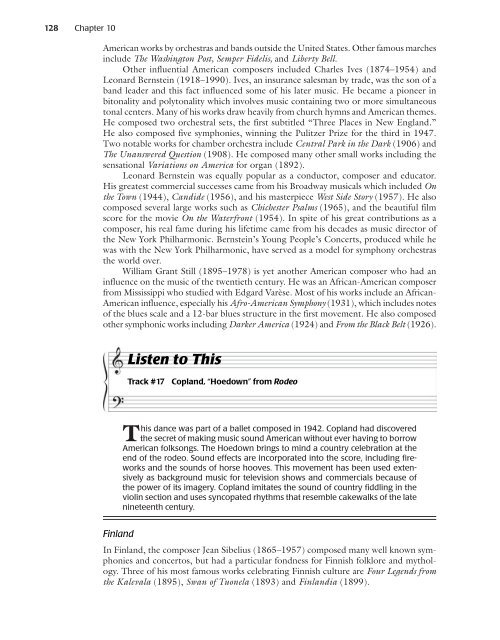Composer Profile - Activefolio
Composer Profile - Activefolio
Composer Profile - Activefolio
Create successful ePaper yourself
Turn your PDF publications into a flip-book with our unique Google optimized e-Paper software.
128 Chapter 10<br />
American works by orchestras and bands outside the United States. Other famous marches<br />
include The Washington Post, Semper Fidelis, and Liberty Bell.<br />
Other influential American composers included Charles Ives (1874–1954) and<br />
Leonard Bernstein (1918–1990). Ives, an insurance salesman by trade, was the son of a<br />
band leader and this fact influenced some of his later music. He became a pioneer in<br />
bitonality and polytonality which involves music containing two or more simultaneous<br />
tonal centers. Many of his works draw heavily from church hymns and American themes.<br />
He composed two orchestral sets, the first subtitled “Three Places in New England.”<br />
He also composed five symphonies, winning the Pulitzer Prize for the third in 1947.<br />
Two notable works for chamber orchestra include Central Park in the Dark (1906) and<br />
The Unanswered Question (1908). He composed many other small works including the<br />
sensational Variations on America for organ (1892).<br />
Leonard Bernstein was equally popular as a conductor, composer and educator.<br />
His greatest commercial successes came from his Broadway musicals which included On<br />
the Town (1944), Candide (1956), and his masterpiece West Side Story (1957). He also<br />
composed several large works such as Chichester Psalms (1965), and the beautiful film<br />
score for the movie On the Waterfront (1954). In spite of his great contributions as a<br />
composer, his real fame during his lifetime came from his decades as music director of<br />
the New York Philharmonic. Bernstein’s Young People’s Concerts, produced while he<br />
was with the New York Philharmonic, have served as a model for symphony orchestras<br />
the world over.<br />
William Grant Still (1895–1978) is yet another American composer who had an<br />
influence on the music of the twentieth century. He was an African-American composer<br />
from Mississippi who studied with Edgard Varèse. Most of his works include an African-<br />
American influence, especially his Afro-American Symphony (1931), which includes notes<br />
of the blues scale and a 12-bar blues structure in the first movement. He also composed<br />
other symphonic works including Darker America (1924) and From the Black Belt (1926).<br />
Finland<br />
Listen to This<br />
Track #17 Copland, “Hoedown” from Rodeo<br />
This dance was part of a ballet composed in 1942. Copland had discovered<br />
the secret of making music sound American without ever having to borrow<br />
American folksongs. The Hoedown brings to mind a country celebration at the<br />
end of the rodeo. Sound effects are incorporated into the score, including fireworks<br />
and the sounds of horse hooves. This movement has been used extensively<br />
as background music for television shows and commercials because of<br />
the power of its imagery. Copland imitates the sound of country fiddling in the<br />
violin section and uses syncopated rhythms that resemble cakewalks of the late<br />
nineteenth century.<br />
In Finland, the composer Jean Sibelius (1865–1957) composed many well known symphonies<br />
and concertos, but had a particular fondness for Finnish folklore and mythology.<br />
Three of his most famous works celebrating Finnish culture are Four Legends from<br />
the Kalevala (1895), Swan of Tuonela (1893) and Finlandia (1899).



